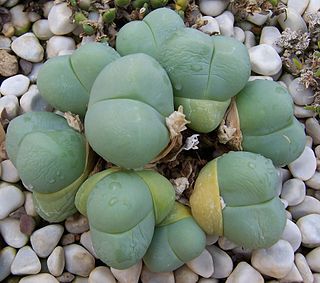
Gibbaeum is a genus of about 21 species of small succulent plants of the family Aizoaceae, indigenous to the Little Karoo region of South Africa. The name "Gibbaeum" comes from the Latin gibbosus (hunchback)

Aloe ferox, commonly known as bitter aloe, is a species of flowering plant in the family Asphodelaceae. This woody aloe is indigenous to southern Africa. It is one of several Aloe species used to make bitter aloes, a purgative medication, and also yields a non-bitter gel that can be used in cosmetics.
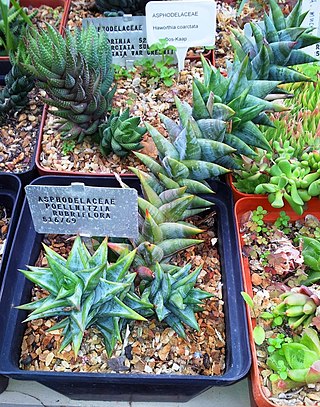
Astroloba rubriflora is a succulent plant found in the mountainous Karoo area around Robertson, South Africa. It is listed as a Vulnerable species on the IUCN global Red List.

AnacampserosL. is a genus comprising about a hundred species of small perennial succulent plants native to Southern Africa, Ethiopia and Latin America. The botanical name Anacampseros is an ancient one for herbs supposed to restore lost love.

Crassula nudicaulis is a succulent plant native to South Africa, and Lesotho.

Cadaba aphylla ("Swartstorm") is one of the many species in the genus Cadaba. It is indigenous to southern Africa.

Felicia josephinae is a roughly hairy annual herbaceous plant of 15–20 cm (6–8 in) high, that is assigned to the family Asteraceae. It branches near its base, and has few leaves along its stems. The lower leaves are set oppositely, inverted lance-shaped, relatively large at 3–7 cm long and ⅔–1¼ cm wide, and soon withering, while the higher ones are smaller and relatively narrower. In the axils of the leaves grow flower heads of 7–8 mm wide on stalks of up to 5 cm (2.0 in) long, topped with an involucre of about 5 mm (0.20 in) high and 4 mm (0.16 in) wide, consisting of eleven to thirteen bracts in two rows with bristles near the tip, eight to nine white or cream-coloured ligulate florets surrounding fourteen or fifteen deep purple disc florets. Flowers can be found in September and October. The species is an endemic species that can only be found in a small area along the west coast of the Western Cape province of South Africa.
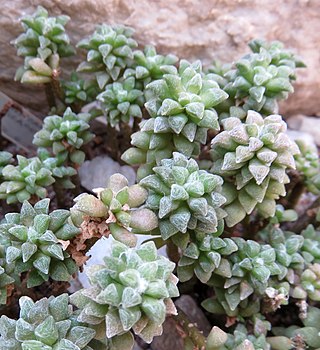
Anacampseros arachnoides is a species of succulent plant native to the Little Karoo region of South Africa.

Anacampseros albidiflora is a species of succulent plant native to the Great Karoo and Little Karoo regions of South Africa.
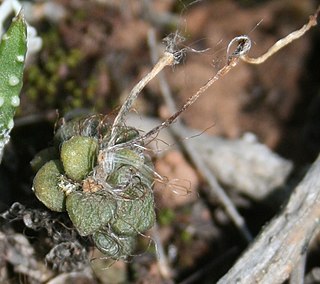
Anacampseros retusa is a species of succulent plant native to the Northern Cape and Western Cape Provinces of South Africa, as well as to Namibia.

Anacampseros telephiastrum is a species of succulent plant native to the southern Karoo region of the Western Cape and Eastern Cape Provinces of South Africa, from Robertson in the west, to Somerset East in the east.

Anacampseros filamentosa is a species of succulent plant native to the Karoo region of South Africa.
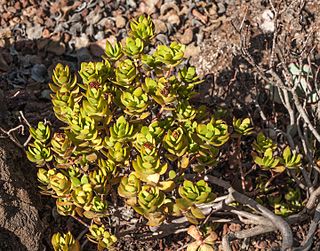
Crassula cultrata is a succulent plant native to the southern parts of South Africa.

Crassula subaphylla is a succulent plant belonging to the family Crassulaceae. It is widespread in the Karoo regions of South Africa and Namibia.
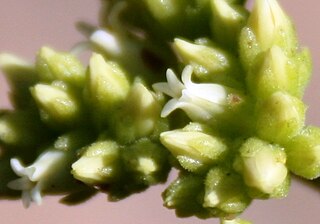
Crassula atropurpurea is a succulent plant, very common and widespread in the southern Karoo regions of South Africa and Namibia.

Macledium spinosum is a variable species of flowering plant in the family Asteraceae, that is endemic to the southern Cape regions of South Africa.

Duvalia vestita is a small succulent plant species, in the family Apocynaceae, indigenous to the southernmost part of the Western Cape Province, South Africa.

Euphorbia tuberosa, commonly known as '"milkball/melkbol"' or '"wilderamenas"', is a variable geophytic plant of the family Euphorbiaceae, indigenous to the western parts of South Africa.
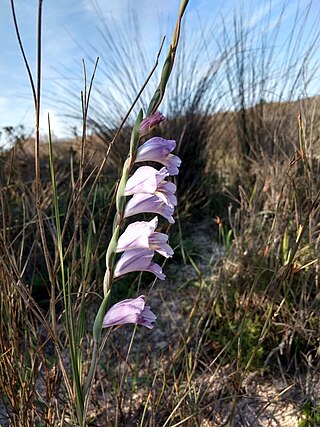
Gladiolus patersoniae is a herbaceous perennial plant belonging to the genus Gladiolus of the family Iridaceae, indigenous to the southern Cape regions of South Africa.

Selago ramosissima is a species of plant in the family Scrophulariaceae. It is endemic to the Western Cape, South Africa.





















